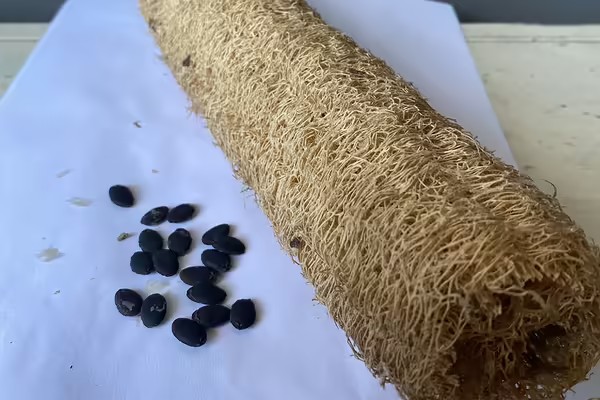
URBANA, Ill. – Gardens can grow a variety of surprising things, but one item you wouldn’t expect to find growing next to beans and tomatoes is a loofah sponge. Still, one member of the Cucurbitaceae family does just that.
While most people think a loofah sponge comes from the ocean or at least an aquatic plant, it’s actually found on a trellis in a garden. A loofah, or luffa, plant is considered a vegetable. Luffa aegyptiaca, is a member of the Cucurbitaceae family like squash or cucumber, says Christina Lueking, University of Illinois Extension horticulture educator. This gourd is starting to show up in farmers markets this time of year which may spark interest in growing it next year.
“The first time seeing one growing you might think it is a very long cucumber,” Lueking says. “The vines grow extremely long and produce edible fruit growing off them which turn into fibrous gourds when left to mature on the vine.”
This outer layer is peeled away to expose the inner fibers that everyone recognizes as a luffa sponge.
The loofah gourds are a unique addition to any garden, especially demonstration gardens for youth.
Loofa seeds should be soaked and started indoors four to six weeks before the last frost. Patience is needed for this plant's 150 to 200-day growing season. It is important to harden off your transplant to reduce transplant shock before planting in the garden.
Loofa plants need full sun and a strong structure to allow the up to 30-foot-long vines to climb and trellis on while producing fruits in three months. Loofah plants need to be trellised for the weight of the green fruit, but as they mature, fruit will dry and lose moisture.
Loofah plants have male and female flowers like winter squash. If pollinators are limited in your garden, hand pollination techniques can be used to pollinate the female flower to increase production. It is recommended that pinching of all flowers and small luffa occur two months before the last frost to direct all the remaining energy to the gourds that will be left to harvest.
These diverse plants can be harvested for eating when they are 4 inches to 7 inches long and are traditionally served in Asian dishes. Depending on your growing zone, you will either harvest brown and lightweight gourds or green gourds. Harvest the gourds with hand pruners from the vines.
“In Southern Illinois’ growing zone 6 climate, we will need to harvest some green fruit that may not be completely dry and brown before our first frost,” Lueking says.
To process harvested loofah, lay the gourd on a hard surface and press down to crack the skin of the gourd. Press your thumbs into the skin and pull the skin apart. This process takes more effort if the skin is still green. Pull the skin or pieces off the fibers to expose a long sponge that contains black seeds.
Rinse the sponge under water and let the sponge sit overnight on a piece of cardboard to dry out. Some seeds might drop during this process, just sit them out to dry. Once dry, you can shake out the remaining seeds over the cardboard and enjoy your new sponge.
For more information on plant care, connect with your local Illinois Extension county office at go.illinois.edu/ExtensionOffice.
Photo by Christina Lueking. While most people think a loofah sponge comes from the ocean, Luffa aegyptiaca, is actually a member of the Cucurbitaceae family like squash or cucumber.
ABOUT EXTENSION: Illinois Extension leads public outreach for University of Illinois by translating research into action plans that allow Illinois families, businesses, and community leaders to solve problems, make informed decisions, and adapt to changes and opportunities.
PHOTO ACCESS: The photo in this article is available to download for media use.